Inherently, we all think that we are a good driver – and that everyone else on the road is…well….not such a good driver.
We don’t know how many times someone has told us “I’ve been drivin’ trucks for 20 years and never had an accident!” You know the rest – “but caused plenty!” This is a natural optimism bias that we all have. It’s also known as denial.
Really, how many drivers out there do you think would actually own up to having got their licence out of a Cornflakes packet and being genuinely crap at their craft? There’s lots of them, but we’re sure you wouldn’t find one who’d own up and upon reflection decide that it was in the best interests of the road-going public to do us all a favour and hand in the their licence and start again.
Unfortunately bad drivers stick out like a sore thumb but good drivers aren’t so easy to spot. In fact you never really see them. Don’t get us wrong, there are also plenty of them out there (we like to think we trained a good chunk of them over our 50+ years in the game!), but you don’t know they’re there because they are not trying to suddenly get over three lanes to make the exit and in doing so making other road users take evasive action. Good drivers give themselves plenty of time and are constantly pre-planning their movements and re-prioritising hazards. That’s why you don’t notice them – they give you no reason to notice them!
So if you ever find yourself riding shotgun, here are 9 signs that you’re sitting next someone who has a pretty good handle on what they are doing (and therefore you can take your foot off the imaginary brake pedal on the passenger side!)
-
They are acutely aware that every person has a blind spot in their eyes. So when they get to an intersection, they scan the intersection with their whole head (not just their eyes), moving their chin from side to side which means that both eyes are working together equally (which means their nose doesn’t get in the way and create a blind spot – truly, try it!)
-
They scan intersections using their whole head and perform at least 2 x 180 degree scans.
- They don’t just “look” left and right aimlessly when at an intersection or at a stop. They think about what they are “looking” for and actively look for those things (hazards and dangers!). Remember we ‘see’ with our eyes, but we ‘observe’ with our minds.
- When they are in a position where something is blocking their vision like a parked vehicle, trees, or utility poles, they NEVER make a decision to go until they have removed that vision-block and have a clear view. That means they’ll stop where required first and then select a gear and creep forward to the point where the vision-block is removed and then they proceed.
-
They know that it is hard to judge distance and speed using peripheral vision and that clear vision comes from their central vision, so they move their head more when scanning on approach to intersections.
- You can see that they are constantly scanning the short, mid, and long- range zones ahead of them.
-
When approaching any type of hazard they instinctively place their foot above the brake because they know that by doing this – in the case that they have to take evasive action – they know this will reduce their reaction time and save them about 12 metres of emergency braking distance at 60km/h.
- They always cover the brake pedal in any case because they know that this is more likely to result in them ‘squeezing’ the brake pedal instead of ‘stomping’ on it (and locking up the wheels) in the event that they have to take evasive action.
- They are constantly prioritising and re-prioritising hazards.
- They work hard to always put their vehicle in the best possible road position on approach to a hazard and do so a minimum of 10-12 seconds before they reach that hazard.
- Their gear changes are smooth and you never hear any ‘crunching’ because they know that timing and the speed at which they change gears are the most important things which affects your ability to change gears smoothly and efficiently in a Non-Synchro. They know that most Non-Synchros have a ‘pull’ clutch which disengages the clutch at a higher pedal point than a ‘push’ clutch. Therefore they know that if you push your clutch fully to floor, it will take more time, slowing down the gear change, and could potentially cause damage to the clutch brake.
- They always set-up properly for left turns by taking the right amount of space on the approach, because they know it’s too late to create extra space once you start the turn.
-
When making left turns they NEVER, EVER, EVER do any of the following:
- Panel Beating (hit other vehicles, signs, or send pedestrians running for their lives!)
- Gardening (hitting trees, branches, ruining curb-side gardens)
- Power Pole Work (hitting poles, wires, stays)
So if you aspire to be known as a ‘good operator’ then you need to undertake your heavy vehicle license training at Armstrongs. You can find all your heavy vehicle license course options on our course pages.
PSST – because you’ve come this far (good on you!) we can tell that you’re exactly the type of person who would be interested to SEE exactly what’s involved in a heavy vehicle driver assessment before you even walk through the door at Armstrongs! Talk about being prepared! You can see how to perform all the crucial skills right here. Happy viewing.


